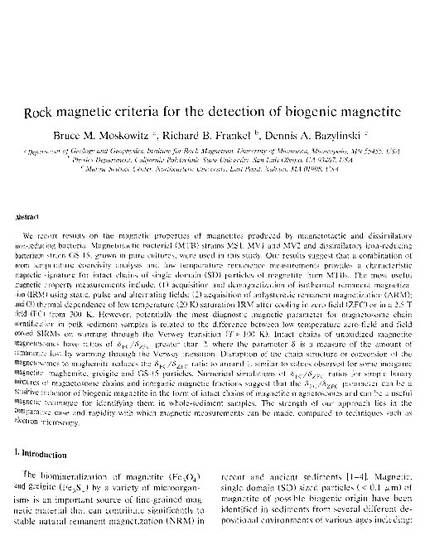
We report results on the magnetic properties of magnetites produced by magnetotactic and dissimilatory iron-reducing bacteria. Magnetotactic bacterial (MTB) strains MS1, MV1 and MV2 and dissimilatory iron-reducing bacterium strain GS-15, grown in pure cultures, were used in this study. Our results suggest that a combination of room temperature coercivity analysis and low temperature remanence measurements provides a characteristic magnetic signature for intact chains of single domain (SD) particles of magnetite from MTBs. The most useful magnetic property measurements include: (1) acquisition and demagnetization of isothermal remanent magnetization (IRM) using static, pulse and alternating fields; (2) acquisition of anhysteretic remanent magnetization (ARM); and (3) thermal dependence of low temperature (20 K) saturation IRM after cooling in zero field (ZFC) or in a 2.5 T field (FC) from 300 K. However, potentially the most diagnostic magnetic parameter for magnetosome chain identification in bulk sediment samples is related to the difference between low temperature zero-field and field cooled SIRMs on warming through the Verwey transition (T ≈ 100 K). Intact chains of unoxidized magnetite magnetosomes have ratios of δFC/δZFC greater than 2, where the parameter δ is a measure of the amount of remanence lost by warming through the Verwey transition. Disruption of the chain structure or conversion of the magnetosomes to maghemite reduces the δFC/δZFC ratio to around 1, similar to values observed for some inorganic magnetite, maghemite, greigite and GS-15 particles. Numerical simulations of δFC/δZFC ratios for simple binary mixtures of magnetosome chains and inorganic magnetic fractions suggest that the δFC/δZFC parameter can be a sensitive indicator of biogenic magnetite in the form of intact chains of magnetite magnetosomes and can be a useful magnetic technique for identifying them in whole-sediment samples. The strength of our approach lies in the comparative ease and rapidity with which magnetic measurements can be made, compared to techniques such as electron microscopy.
Available at: http://works.bepress.com/rfrankel/115/
